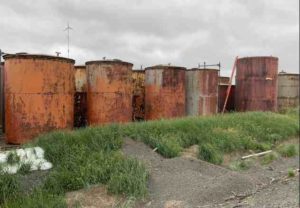
The area of responsibility for U.S. Coast Guard Sector Anchorage is by far the largest and most remote of any Coast Guard sector in the nation. Capt. Sean MacKenzie, sector commander, exercises authority in a jurisdiction extending throughout Western Alaska to the North Slope, and from the Aleutian Islands through Prince William Sound—an area that covers approximately 5.3 million square miles and more than 35,000 miles of shoreline.
Within this area of responsibility are fuel facilities that are critical to the survival of communities in Western Alaska, where fuel in sub-freezing winter months is essential to home heating and subsistence. Many of these fuel facilities have experienced some degree of deterioration over time, from fatiguing metal to eroding shorelines and tundra upheavals, all of which impact infrastructure stability and longevity.
The majority of these facilities are also unreachable by automobile. In 2019, Coast Guard Sector Anchorage personnel executed an innovative plan to assess these remote facilities in order to determine their condition and identify facilities vulnerable to oil spills.
The sector is responsible for inspecting roughly 380 of these bulk oil waterfront facilities, 346 of which are not on the Alaska road system.
In order to accomplish this daunting task, Sector Anchorage personnel began in 2018 to devise an intricate plan designed to meet the staffing, transportation and fiscal needs of conducting these inspections with increased frequency and efficiency. That plan, the Marine Safety Task Force initiative, was launched in the spring of 2019. In an unprecedented effort, MSTF teams inspected nearly 60 percent of those facilities—almost five times more than last year.
[content id=”79272″]
“In the lower 48, Coast Guard inspectors can simply drive to fuel storage facilities to conduct inspections,” said MacKenzie. “Up here in Alaska, getting our folks to these places requires flying and often demands expensive lodging. Working with budget and personnel limitations during the Coast Guard’s busiest time of year are just a few of the challenges we overcame this year.”
Sector Anchorage relied heavily upon Coast Guard active duty and reserve members from other Alaska units, as well as members stationed in the lower 48 on temporary duty orders to complete the inspections. A crucial component of the MSTF was also made up of volunteers who did not wear the Coast Guard uniform.
Sector Anchorage was supported heavily by the Air Force’s Civil Air Patrol for transportation from hub communities to remote villages. CAP is comprised of volunteers, much like the Coast Guard Auxiliary.
Pages: 1 2








